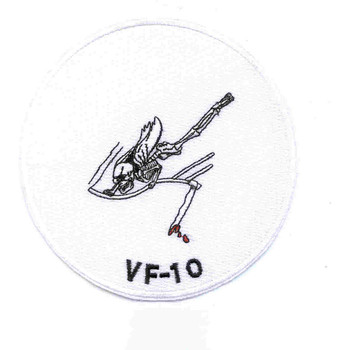Description
VF-101 Grim Reapers US Navy Fighter Squadron Patch 4.50" x 4.00" Embroidered Patch with Iron-On Backing
Superior Materials: Made with premium polyester thread and durable twill fabric, ensuring long-lasting color and strength.
Advanced Embroidery Technology: Crafted using the most advanced embroidery machinery, guaranteeing intricate detail, sharp lines, and consistent quality every time.
Easy Iron-On Application: Features a heat-activated adhesive backing for quick, no-sew attachment. Simply position, iron, and press for a secure bond.
Versatile Use: Perfect for personalizing jackets, backpacks, uniforms, or any fabric surface that needs a touch of personality.
Durable and Washable: Designed to withstand everyday wear and occasional washing without fading or fraying.
Formations & Origins
The “Grim Reapers” of Fighter Squadron 101 (VF-101) trace their origins to 1942 during the fierce early years of World War II. Though initially designated under different squadron numbers, the VF-101 identity solidified in 1952 as a Fleet Replacement Squadron for the U.S. Navy’s East Coast fighter community. From its home at NAS Oceana, VF-101 became synonymous with elite-level pilot training and readiness.
The squadron’s ominous insignia—a skeletal reaper with a scythe—signaled the lethal skill of the pilots it trained and the grave seriousness of its mission.
Notable Commanders
While many VF-101 commanders remain lesser known outside naval aviation circles, their influence resonates in every carrier air wing that deployed with fighter pilots forged under their watch. Several went on to command carrier strike groups or instruct at the Navy Fighter Weapons School (TOPGUN), shaping the tactical doctrines of modern aerial warfare.
Major Campaigns/Operations
As a training squadron, VF-101 did not deploy into combat but enabled nearly every Navy fighter deployment from the Vietnam War through Operation Iraqi Freedom. Its graduates went on to fly in:
-
Vietnam War — F-4 Phantom combat sorties
-
Cold War — Intercepts and readiness patrols
-
Operation Desert Storm — Carrier-based Tomcat strikes
-
Operation Enduring Freedom — Post-9/11 air superiority missions
-
Operation Iraqi Freedom — Final carrier operations for the F-14
VF-101's mission was to prepare pilots and radar intercept officers (RIOs) for the high-stakes world of carrier-based dogfighting, reconnaissance, and precision strike.
Specialized Role/Equipment
VF-101 became legendary for training crews on the F-14 Tomcat, the Navy's premier fleet defense and air superiority fighter from the 1970s through the early 2000s. The squadron also operated:
-
F-4 Phantom II
-
F-2H Banshee
-
F/A-18F Super Hornet (late period)
Its curriculum included carrier landings, aerial combat maneuvering, long-range interception, and multi-role strike capability. VF-101 pilots learned to tame complex jets and operate in one of the most unforgiving environments on earth: the flight deck.
Acts of Heroism
VF-101's legacy is etched into the courage of its graduates—pilots who flew into combat zones, rescued fellow aviators, and flew damaged aircraft home. One story often repeated in naval circles involves a Tomcat crew who, after being hit over Iraq, limped their jet back to the carrier thanks to training from the Grim Reapers that taught them how to handle catastrophic system failures under fire.
These were the aviators who launched at night, in stormy seas, with full afterburners and full responsibility for the mission—and for each other.
Legacy & Notable Achievements
VF-101 Grim Reapers are remembered not just for their intimidating name and symbol, but for their unwavering commitment to combat readiness. The squadron was deactivated in 2005 with the retirement of the F-14 Tomcat, briefly reactivated for Super Hornet training, and formally deactivated again in 2019.
But the legacy lives on. Every fighter pilot who trained under the Reapers carries their ghost into the sky—skilled, steady, and always a little dangerous. This patch honors that legacy and the thousands of aviators who were once reaped, trained, and sent forth to own the skies.






